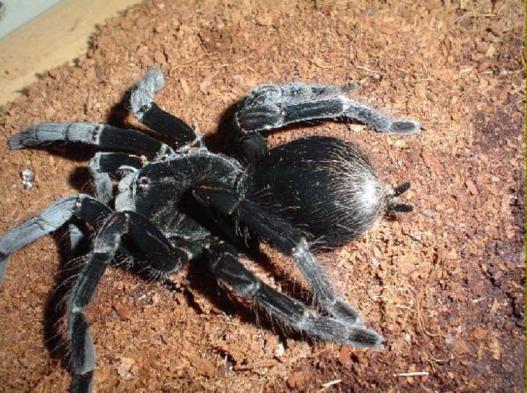
Pamphobeteus antinous
Michal Toran
This beautiful
terrestrial spider lives in Peru and Bolivia, predominantly in tropical forests. Its basic coloration is brown, but freshly moulted specimens are velvety black and the abdomen is partly covered with
pale hairs. The colours of extremities range from brown to black, but in some cases they can even be bluish. The adult female that I keep is 7.5cm (about 2 inches) big but since it's a young
specimen, this size may not be final. The size of a spider may also be dependent on the place where it comes from. Spiders from some areas in Bolivia are often larger than those from Peru. The size
of a Bolivian adult female can reach up to 11cm (2.5 inches), which means they come very close to the size of Theraphosa blondi. Under the right conditions, males grow mature after some 2.5 years,
females after 4 years. The terrarium for this species is made of glass, of dimension of 30x30x25 cm (width x length x height). After moulting, I'll understandably move the female to a terrarium of a
bigger size. For the bottom, I used lignocel, which is a coconut grit similar to peat or soil, making an approximately 5cm depth. Other equipment for the terrarium is a shallow earthenware water dish
and a hiding place made of an earthenware flower pot of appropriate size. The temperature is around 25 or 26°C (locally, it reaches 28°C, because there's a heating electric cord 30W on the right side
of the terrarium). Air humidity is lower, about 65% - 75%. Half of the terrarium is completely dry, the other has condensation when needed. For feeding, I mostly use large crickets and locusts.
This female is afraid of new born mice, but sometimes, it accepts a dead one. Taking care of the young ones is not very different from any other tarantula. Being disturbed, this species holds
its abdomen against the aggressor and kicks its hairs, which, in contact with skin, cause disagreeable itching. Obviously, it's not an highly defensive species, although some sources mention its
alleged aggressiveness. Throughout the day, they spend most of the time hidden in its retreat and are more active during the night. It very often drinks from the water dish, and so it's necessary to
regularly change the water. Spiderlings and juveniles are pale and they have a ‚'Christmas tree' design on the abdomen, which is actually true for most of the young ones belonging to this genus. I
have no personal experience with breeding, because I haven't found an adult male for pairing but some foreign colleagues say the number of eggs in one cocoon can be counted in tens, but it
exceptionally reaches hundreds.
P. antinous is a splendid species, which
will always become a pride of every collection. I wish you successful breeding!
